In many regions extreme summer flooding seemed to persist and smacked most anglers in the face like an out of season salmon. Fortunately, we got away very lightly in my part of the country to the east and it was pretty much business as usual; it just made me reflect that as anglers we are very much at the mercy of Mother Nature.
The conditions were certainly very much in contrast to the end of last season when we had the longest sustained period of drought in living memory when many of the local rivers I fished at the ‘back end’ looked weary, stagnant and forlorn. Nearly all of my favourite winter swims were carpeted with a thick filamentous blanket of black, stinking weed leaving them unfishable.
All was not as lost as it seemed though as towards the dying embers of the season rain materialised from nowhere, lifting water levels to those more typical of a winter river and once again sport picked up. It just served as a reminder that our sport is so at the mercy of the irregular weather patterns we experience in these unpredictable times!
By mid April the close season really felt like it was dragging on and the heavy rain and resulting floods seemed an untimely insult! However, in time, the pattern of nature returned and spring normality returned – albeit a month behind.
The secret lives of fish
The close season is by far the best time to explore and find out the potential of virgin areas of river. Big chub seem to adopt a carefree attitude and I have often wondered if they actually know that it is safe to behave in a more natural way. Looking through my records, I can see that the effort put in during this forced period of abstinence can have a dramatic investment on returns!
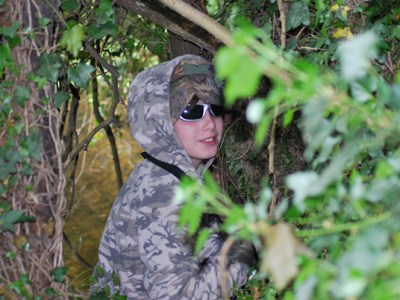 A fascinating aspect to fish observation has been photographing fish within their watery realm and identifying individuals using scuffs, scrapes and various morphological anomalies. I have now built up quite a catalogue of fish, which from time to time can be identified on the bank. Having done this for a number of years, I am fairly confident to propose that it is highly likely that most chub are rarely, if ever caught, whilst others seem to come out with some regularity – not unlike their still water cousins, Cyprinus carpio.
A fascinating aspect to fish observation has been photographing fish within their watery realm and identifying individuals using scuffs, scrapes and various morphological anomalies. I have now built up quite a catalogue of fish, which from time to time can be identified on the bank. Having done this for a number of years, I am fairly confident to propose that it is highly likely that most chub are rarely, if ever caught, whilst others seem to come out with some regularity – not unlike their still water cousins, Cyprinus carpio.
Fish spotting really could not be simpler and is not as difficult as many think. Drab clothing, peaked hat, Polarizing sunglasses, a bit of stealth and plenty of patience are all you need. If you use the available cover of reeds, tree canopies and bushes it is remarkable how close you can get without causing concern – it really is child’s play!!
My preferred conditions are bright, windless days; I usually arrive on the river between 11am and 4pm working slowly in an upstream direction taking care not to take heavy steps or cast my shadow on the river. It takes time to accustom your eyesight to an alien environment and much more is seen if time is taken just to sit and look for any movement out of place with the rhythm of the flow. I find fish spotting is far easier in the close season; perhaps it is lack of angling pressure, maybe the weed growth has not quite proliferated – in reality it probably has far more to do with the fish collecting near spawning grounds in preparation for the big event.
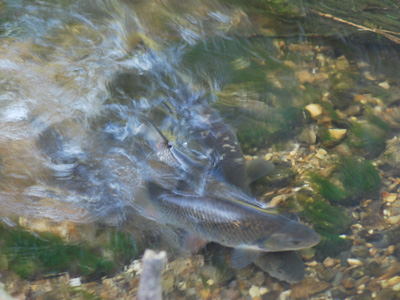 For me, the personal highlight this year was witnessing the spectacle of spawning chub over shallow, gravel runs. I was acutely aware that the average size of chub that took part in this mass event was typically that of smaller individuals. Indeed, larger fish were still lazing around basking in the warm May sunshine and happy to carry on feeding. This was consistent in that having caught some of the larger individuals in June they still looked full and gravid.
For me, the personal highlight this year was witnessing the spectacle of spawning chub over shallow, gravel runs. I was acutely aware that the average size of chub that took part in this mass event was typically that of smaller individuals. Indeed, larger fish were still lazing around basking in the warm May sunshine and happy to carry on feeding. This was consistent in that having caught some of the larger individuals in June they still looked full and gravid.
Pre-baiting
Having located groups of chub, pre-baiting then plays an important role in my angling approach and is easily fitted around my lifestyle; my dog ‘Wooster’ accompanies me on our walk after work! It does incur a modest financial investment and is therefore carefully thought through and I like to have at least five areas where I focus my efforts as this is manageable and allows for minor disasters – like someone else discovering your plans – something I try to avoid at all costs!
As I plan to return to specific swims on a regular basis, it is essential to try and make minimal disturbance to the bankside vegetation. It is a good time to do a little light pruning, but it is advisable not to crush and trample around too much as this really gives the game away!
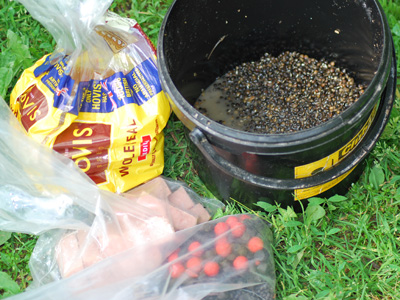 To hold fish in a certain area and coax them from cover there really is little to beat hemp and sweetcorn. In addition to this, I introduce a variety of free offerings so that they gain some reliance on the baits I intend to use when fishing and to naturalise them into accepting these readily.
To hold fish in a certain area and coax them from cover there really is little to beat hemp and sweetcorn. In addition to this, I introduce a variety of free offerings so that they gain some reliance on the baits I intend to use when fishing and to naturalise them into accepting these readily.
To keep costs down I purchase a bulk sack of hemp, a few kilos of halibut pellets, economy sweetcorn and any use up any left over bollies. It is good to remember that chub are not fussy eaters and any offerings are gratefully received!
It is in this arena I like to experiment: slugs and snails flicked into the swim whilst fish are pre-occupied on particles, luncheon meat taken on the drop – you’ll be surprised how little reaches the river bed – splitting the shoal, reactions and confidence levels to different baits; it’s fascinating.
The big bonus of pre-baiting is that you can condition fish to expect finding food in a certain place, at a certain time. They are very much creatures of habit and I have found that as most of my pre-baiting takes place between 7 and 8pm, if I introduce food at a different time, more often than not it is ignored for a considerable length of time.
Opening night
My typical approach to early season chubbing has changed dramatically over the years and instead of long sessions I find short, sharp, ‘hits’ on the riverbank far more productive. The exception to this rule is opening night, however, this year it was not to be the bonanza I had desired or anticipated.
I simply adore and crave that feeling of expectation when the rod is cast into the river for the first time in three months. Arriving on the river in the early part of the evening of 15 June was actually quite nerve wracking; mentally, casts are made into individual swims, clear areas and landmarks are committed to memory, a bottle of ale is opened with a toast to the river in anticipation of the birth of the forthcoming season.
Fears of mis-casting and crashing clumsily into a swim were put aside on the stroke of midnight, a size two hook is concealed within two coarsely torn cubes of luncheon meat and gently cast into the oily, dark abyss – timed and feathered down to perfection. The line falls slack; I gently pull back the bait and observe the effect on the tip of my feeder rod; it feels perfect as it trips back a few inches indicating it has found a resting place on the clear gravel patch. Introducing a bow in the line, the lightest of bobbins is fastened on a long drop – I like this additional form of indication as I feel it gives a wary fish a little more confidence under minimal resistance.
Everything in place, I draw deeply on a cigarette trying to focus on the twin beta antenna indicators that define the slight deflection of the tip. I enter an instinctive and primitive heightened sense of consciousness, poised to act. A hesitant twitch!!!! Heart race pulsing, an instant metallic sensation floods my taste buds… the line tightens as the tip folds over, the bobbin jerks and, on rising steadily, is met by a firm strike… into thin air…
Not normally prone to the destructive emotions of despair this time I relent and expel an expletive under my breath. A recast is made but having showed my hand a move was required to recharge my anticipation. To summarise opening night: a Chub of 4lb 9oz and a six pounder!!! Well, a bream weighing 6lb 1oz…
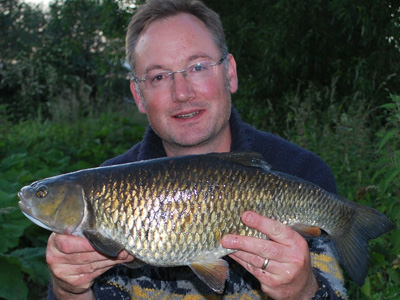 That was certainly disappointing considering the volumes of fish present and the number of swims I had ‘sampled’. My thoughts on pre-baiting, based around specific times, perhaps suggest a flaw in this approach. It is only speculation but, perhaps, my actions had an unanticipated effect due to an effect on conditioning chub behaviour and I would be interested if anyone else has observed a similar effect.
That was certainly disappointing considering the volumes of fish present and the number of swims I had ‘sampled’. My thoughts on pre-baiting, based around specific times, perhaps suggest a flaw in this approach. It is only speculation but, perhaps, my actions had an unanticipated effect due to an effect on conditioning chub behaviour and I would be interested if anyone else has observed a similar effect.
A few days later I did manage to extract a very nice chub of 5lb 10oz to a slow sinking bread presentation comprising a whole slice of bread (minus the crust) on a Korda size two Wide Gape hook; the bread squeezed just sufficiently to allow it to just sink and settle under its own weight. The 12lb line I deploy for this method may seem like overkill but the coils and visible thickness are the indication; it is simply a case of watching them straighten and cut across the water.
Super stalking!
If you are fortunate enough to have a river where it is possible to watch your quarry stalking tactics can prove supremely successful in selectively targeting bigger fish. It is also the definitive method where time is short as it requires so little preparation; tackle can be stripped down to its simplest form – in fact everything you are likely to need can be stashed in a couple of pockets.
My rod is a Drennan 1.5lb test ‘Super Specialist’, matched with my old faithful Shimano 3000GTM spooled with the superb Drennan ‘Super Specialist’ mono in 6lb – it is tough as old boots and man enough to cope with being dragged through submerged tree roots under tension. My pockets are filled with hooks in sizes 6, 4 and 2, swan shot, scales and forceps covering all eventualities. My camera and tripod are the bulkiest of my requirements and a necessity due to the procedure of self take photography. A Gardner specialist landing net handle and deep pan net complete the set-up.
I do have a habit of exploring the weird and the wonderful in terms of baits that can be used for stalking but more often than not it is a case of simple availability. In this instance an abundance of garden snails and my desire to protect my lily-like Hostas from being eaten came to the fore and quickly gathering a couple of dozen of the blighters seemed the right thing to do! I prefer snails to slugs as they are easier to handle; I do crack them out of their shells though – a simple procedure: with forceps gently crack either side of where the centre of the spiral forms and then shell them. Mounted on a size two hook their homogenous lack of definitive shape and resulting ‘plop’ when they splash down looks and sounds just right to Mr Chevin.
Having spent many hours observing chub feeding over beds of bait it is not uncommon that smaller fish are the first to become preoccupied on particle baits. Larger fish are much more competitive for baits ‘plopped’ into their immediate vicinity and I suspect that fish which have become accustomed to being fed in a certain place in relative safety are actually quite naive and trusting to a presentation that has been so rewarding regarding their past experiences or so I thought…
This time around the first cast into a swim and my snail bait landed on the surface with a satisfying ‘plop’ but was only nudged by two individuals as it descended to the bottom…
Now, every time I had previously flicked a bait into the water it was engulfed instantly; the only difference this time around was that I had rod in hand. Even confident chub are very ‘switched on’ and they noted the additional presence of a rod over their sky line. In this instance I felt it best to leave well alone and return later, modifying my approach.
A change of position, just upstream, facilitated a cast out of sight with a very surprising result. I could not actually see the fish take the snail but, finger poised on the open spool ready to give line, the line straightened and with my finger removed, the fish took off confidently before I closed the reel and pulled into it. After a short battle when the fish tried to bury its head in the near bank cabbages it was extracted and returned a little way upstream – a superb looking fish going 4lb 9oz.
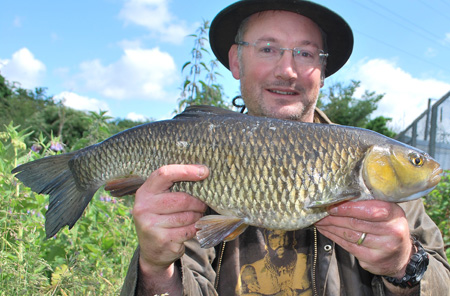 I took advantage to peer into the swim and was encouraged that the fish did not look too perturbed by the loss of their companion. I looked at the mangled snail and suspected the effort required to shell out another would not offer a return considering the recent commotion, so casually flicked it back into the swim – just to be polite really.
I took advantage to peer into the swim and was encouraged that the fish did not look too perturbed by the loss of their companion. I looked at the mangled snail and suspected the effort required to shell out another would not offer a return considering the recent commotion, so casually flicked it back into the swim – just to be polite really.
Much to my surprise another fish took the bait; I hurriedly slammed the bail arm shut, struck, and marvelled as my rod took on a satisfying curve – the fish boring deep within the cavity of its willow branch canopy. Quickly beaten I was admiring my second five of the season in the folds of my net, a stunning chub of 5lb 6oz. Two chub within five minutes, same swim, same bait and one of them a ‘five’ to boot!!
Where a chub is hooked in clear water it is quite common for other members of the shoal to jostle the hooked fish in an effort to bring it into conformity with the rest of its shoal members. It must generate a degree of panic which is communicated throughout the shoal. This incident reinforced to me how important it is to return fish a safe distance from the rest of the fish – returning a stressed fish kills a swim dead.
 It would be fair to say that the dog has not benefited from so many river walks in its life and my wife even praised my recent devotion, bless! The rod accompanied my every walk, casually observing, actively fishing. Baits varied between slugs and snails depending on availability and as the opening month of June progressed the chub were still happy to oblige and a third good fish of 5lb 3oz came out to the ever faithful snail just on a hunch.
It would be fair to say that the dog has not benefited from so many river walks in its life and my wife even praised my recent devotion, bless! The rod accompanied my every walk, casually observing, actively fishing. Baits varied between slugs and snails depending on availability and as the opening month of June progressed the chub were still happy to oblige and a third good fish of 5lb 3oz came out to the ever faithful snail just on a hunch.
This style of fishing is not just limited to direct visual contact – it always pays to drop a bait into swims that just look like a chub ‘should’ be present, taking a ‘fortune favours the brave’ attitude, it paid off in this instance as I weaved the cast between the branches right within a fallen tree canopy.
What I love most about this type of fishing is the unbridled freedom it offers. It presents challenges and a form of creativity that makes it thoroughly absorbing. I have clawed my way through bushes, climbed trees, jumped in to extract snagged fish, been stung beyond belief on hands and knees and simply learnt far more about my quarry than had I adopted a more sedentary approach. If there is such thing as a purist form of stalking, the experience that most epitomises this tactic is to drop a slug on the tail of a chub only for its instinctive reflex reaction to bolt round and engulf the offending item…They just can’t help themselves!
The art of stalking has little changed in centuries and it only seems fair to give credit to Izaak Walton himself for so adeptly describing the art in a way that became so alive and vibrant on my own riverbank…. It was as if Walton’s footsteps had fallen gently beside my own, his words of wisdom gently filling the soft summer air…
‘Go to the same hole in which I caught my Chub, where, in most hot dayes you will find a dozen or twenty Chevens floating near the top of the water, get two or three Grashoppers as you go over the meadow, and get secretly behind the tree, and stand as free from motion as is possible, then put a Grashopper on your hook, and let your hook hang a quarter of a yard short of the water, to which end you must rest your rod on some bough of the tree, and it is likely the Chubs will sink down towards the bottom of the water at the shadow of your Rod (for a Chub is the fearfullest of fishes,) and will do so if but a bird flies over him, and makes the least shadow on the water: but they will presently rise up to the top again, and there lie soaring till some shadow affrights them again: when they lie upon the top of the water, look out the best Chub, which you setting your self in a fit place, may very easily see, and move your Rod as softly as a Snail moves, to that Chub you intend to catch; let your bait fall gently upon the water three or four inches before him, and he will infallibly take the bait, and you will be as sure to catch him: for he is one of the leathermouth’d Fishes, of which a hook does scarce ever lose his hold: and therefore give him play enough before you offer to take him out of the water. Go your way presently, take my Rod, and do as I bid you, and I will sit down and mend my tackling till you return back’.










